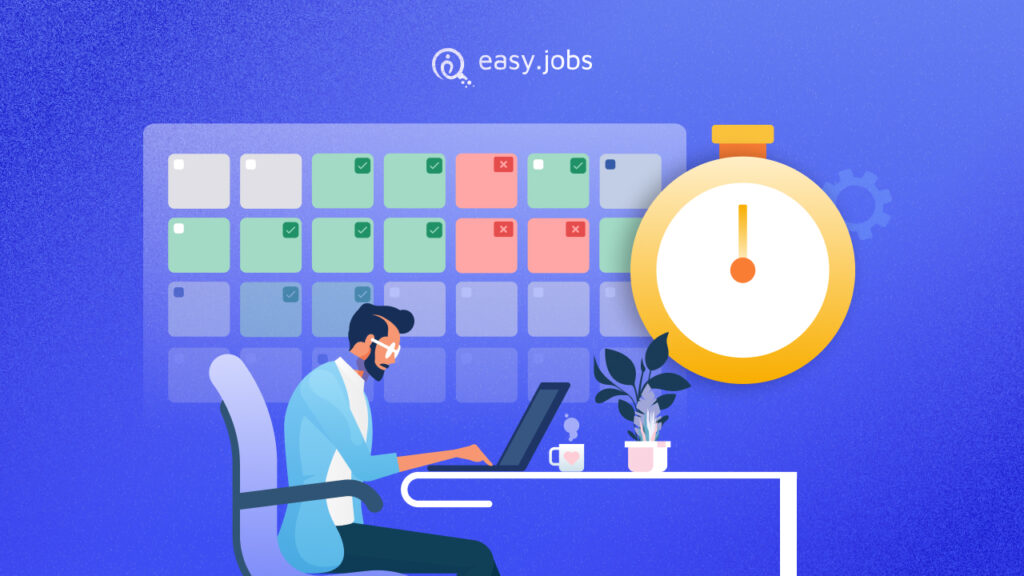When opening any job post for a specific position, you must conduct job analysis and do thorough research to analyze the job as a recruiter. Job analysis involves the entire process of gathering all information on required skills, roles, and responsibilities to create a proper and valid job description.

Before any job openings, each and every detail related to the job should be studied. This thorough analysis gives an overview of the activities necessary for a particular professional position, its relative importance and the conditions under which the job needs to be performed.
Objective And Purpose Of Conducting Job Analysis
The main objective to conduct a job analysis is to answer some basic questions that are important to find out for any company while recruiting for a job or opening a new job. For increasing employee job satisfaction, this is also required. The key concern behind job analysis is to answer questions such as:
👉Why the job designation is necessary?
👉What are the activities the workers need to perform
👉How employees are undertaking the job?
👉How qualified the candidates are to perform the job
👉What are the scopes and risks associated with the job
Why Do You Need To Conduct Job Analysis For Your Company
For any company, the topmost priority is to recruit the right talent who is capable of giving the best performance on the task they are assigned. So, it is important that the person you hire is the best fit for the particular position in your company. To hire the right person, you must know what roles and responsibilities they are being selected for.

If you want to have a clear sketch of the roles and responsibilities, you need to conduct job analysis first so that you can recruit the proper person for that particular position. Studying a job involves an assessment of every detail related to the job. It helps in structuring the workforce and upholding the performance standards of the company.
Job analysis also helps assess the risks associated with the particular job and take necessary steps in maintaining the health, safety & security measures of the company. The first step in the recruitment process is to conduct job analysis that benefits you in a number of ways as a recruiter.
👉 Helps Select The Highest Potential
When you are recruiting, it is important that the person you select is qualified enough for the position. So when you conduct job analysis on the required skills, qualifications, and job responsibilities, it gets easier for you to recruit the right person who meets all the requirements to be a part of your company.
👉 Speeds Up The Recruitment Process
The recruitment process for any company can be tiresome and messy if not organized properly. If you are not clear about what qualifications and skills you are looking for in the candidate, it’s very much likely that you end up hiring a person who is not a good fit for the position. An insightful job analysis leads to a fruitful recruitment process that helps both the employer and the employee you are recruiting.
👉 Helps To Avoid Confusion Over Responsibilities
When you do not conduct job analysis properly, the job details will be incomplete and misleading. While sharing any job openings, you must be clear on what you are looking for. Your job description must be clear and specific devoid of confusion. Otherwise, candidates may become confused and end up applying for the wrong designation. If you conduct job analysis properly, it helps keep these things clear and organized which is necessary for the hiring process.
👉 Makes The Decision Making Process Easier
Decision making is an important step while you are hiring. When everything is organized and easily understandable, decision-making gets faster and uninterrupted. There should be little room for confusion when selecting the proper fit for your organization. When you conduct job analysis insightfully, you know what you are searching for so you can finalize your decision easily. Again, whenever any existing employee leaves the organization, you can replace candidates easily for the vacant positions.
👉 Allows Proper Assessment And Training
Job analysis requires the identification of skills and qualifications. You will be able to evaluate the candidates properly if you conduct job analysis. Again when you are well aware of the necessary requirements, you can facilitate the company’s training programs accordingly, help your employees grow their skills and increase creativity. This is effective in scaling up your organization’s overall performance.
Components To Conduct Job Analysis Appropriately
Before posting on any job openings, you need to bring forward an elaborate description of the job. Job analysis answers some basic questions required for any job posting. There are some essential components of job analysis. Such as,
-
Job Position Or Designation
The first and foremost thing an applicant looks at is, the designation or job position he is applying for. To share any job openings you need to specify the job position so that the applicants know for which position he is applying.
-
Job Description
Each job position differs from others and requires a different set of skills, expertise, tasks and responsibilities. So when you are elaborating on a job description, you need to mention the requirements clearly. This helps the candidates to understand whether they hold the caliber and qualifications for the position or not. For this, it is important that you conduct job analysis insightfully.
-
Work Value
Before any job analysis, you must first estimate how the job position is going to add value to your company, and why this is important. Job value is an estimate of the contribution of the job to the overall growth of the organization.
How To Conduct Job Analysis: Step By Step Guide
Conducting job analysis is a time-consuming process but the outcome is fruitful if done sincerely. There are some basic steps to follow while studying and assessing the job. Here are the steps to follow for a successful job analysis.
1. Find Out The Job Requirements
A job analysis means you need to understand the job deeply so that you can be specific on the requirements. To have a clear understanding of the daily activities the employees need to undertake, finding out the job requirements is the first step. You can collect information from existing employees, arrange a meeting with the team or conduct a survey to inquire about the job and to get a comprehensive overview of the required skills and qualifications.
2. Explore Similar Job Descriptions
To stay ahead of your competitors, you need to explore as much as you can. In the struggle to find the highest potential, staying unaware of what your competitors are doing is not commendable. To enrich your job description and hire the right talent, you need to learn how others are sharing it. So, explore job descriptions from a range of organizations to prevent overlooking important components of the work.
Do thorough google research, stay up to date about your competitor’s job board, and check other companies’ job descriptions to come up with a proper, detailed job description.
3. Define The Outcomes And Expectations
Be specific about the outcomes that you expect to achieve from the job. You need to evaluate first, how this job position is going to help your company’s growth and performance. When expectations are clearly defined, confusion becomes avoidable. The aim here is to make it easy for everyone in your business to understand what someone in this position does and how they contribute to achieving your organization’s goals. To do so, you need to do the following.
👉 Clearly mark out skills and qualifications to be successful in this role
📋 Sketch the organization’s operational goals
🎯 Set expectations from the new employees
🗓️ Create a timeline for the reviewal process

4. Inspect The Job Efficiency
Before you start to craft and conduct job analysis, understand your organization’s needs and find out the scopes of a particular job position. Instead of conducting job analysis only for new jobs, do it for all the available jobs. You may then evaluate the responsibilities and outcomes to see whether a different position might be more suited for specific tasks. Review if there are any loopholes in the completion of any tasks or projects. If so, find out what job role could minimize the gap or could be best suited for the task and work accordingly.
5. Facilitate Training And Development Programs
To achieve collective organizational goals, it’s important that you provide sufficient training and skill development programs to the employees. When you hire a new employee based on job requirements, you need to train up the newly recruited employees so that they can perform better and contribute to the company’s long-term and short-term goals. It will get easier for you to determine the nature of your training initiatives and plan accordingly if you conduct job analysis in a proper way.
6. Determine The Salary of Bands
A job analysis can resolve the tricky task of defining salary allotments for specific job positions. Analyzing key job details helps to disburse salary. Review your competitors’ salary offerings, skim through your company’s current salary bands and adjust it accordingly.
7. Help To Evolve The Job
As time passes, it’s very likely that your employee’s needs and expectations will change. So, after you’ve conducted your job analysis, don’t stop updating it. keep improving the job analysis to help your employees advance in their careers. Examine whether to add any additional responsibilities or outcomes to the job analysis. Role expectations transform over time. Keeping updates about your competitor’s job descriptions, considering employees’ remarks and maintaining your company’s morale should be a constant process.
What Methods You Can Pick To Conduct Job Analysis?
You can pick any method that you consider to be suitable to do the job analysis. No matter what method you choose, the objectives must be kept in mind for a fruitful outcome. Here are the methods you can choose to do job analysis.
✴️ Taking Interviews
Interviews can be an option to collect information from the employees and create a proper job description. You can ask existing employees about their job nature, its necessary requirements, skills, qualifications and responsibilities.
✴️ In-depth Observation
Observing the employees how they work and completing their tasks can be another way to conduct job analysis. This will give the employers firsthand information on the tasks and activities needed to undertake for a particular job.
✴️ Structured Surveys
Surveys are another tool to collect information on job nature, necessary requirements, and how much time and skills are needed for a job. Employees can be given a set of questions to answer about the job and share their suggestions or recommendations.
✴️ Maintaining Work Logs
Employees can maintain a daily task list for a certain timespan where they will write about the work they need to do. This helps to give a clear picture of the job’s nature and write proper job descriptions.
Conduct Job Analysis Insightfully & Help Your Company Grow
As the first step of a company’s recruitment process, there should be a sincere effort in job analysis. An appropriate job analysis benefits the company in many ways. From speeding up the recruitment process to balance the workforce, job analysis plays a vital role. It is a time-consuming process but the outcome is immense.
To know more about managing your workforce and organizing your company, don’t forget to subscribe to our blogs and join our Facebook Community for all the latest updates.









